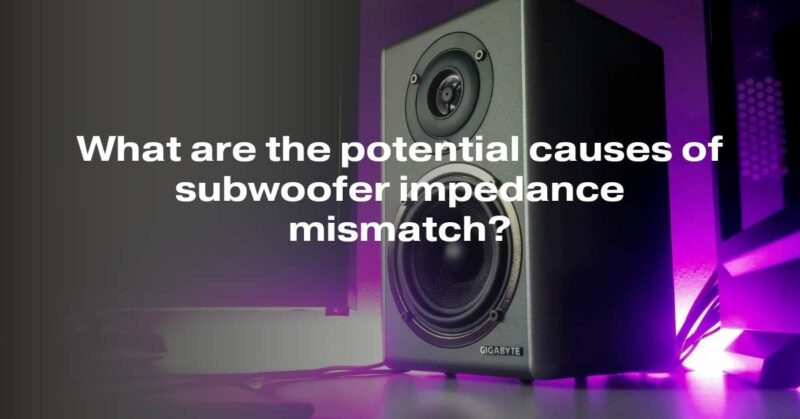Subwoofers are essential components of any audio system, delivering deep, powerful bass that adds depth and richness to music and home theater experiences. However, to ensure optimal performance and prevent damage to your subwoofer and amplifier, it’s crucial to match the subwoofer’s impedance with the amplifier’s output impedance. When there’s a mismatch in impedance, it can lead to various issues, including reduced sound quality, overheating, and even equipment damage. In this article, we will explore the potential causes of subwoofer impedance mismatch and discuss solutions to address these issues.
- Impedance Basics
Before delving into the causes of subwoofer impedance mismatch, it’s essential to understand impedance. Impedance is a measure of the opposition to the flow of alternating current (AC) in an electrical circuit. It’s represented in ohms (Ω) and is similar to resistance but takes into account both resistance and reactance (a measure of how a component resists changes in current and voltage). In audio systems, impedance plays a crucial role in ensuring that the amplifier and speakers work together harmoniously.
- Causes of Subwoofer Impedance Mismatch
a. Subwoofer and Amplifier Mismatch: One of the most common causes of impedance mismatch is using a subwoofer with an impedance rating that doesn’t match the amplifier’s output impedance. Subwoofers typically come in various impedance ratings, such as 4 ohms, 8 ohms, or 2 ohms. The amplifier should be able to handle the subwoofer’s impedance to avoid mismatch issues.
b. Connecting Multiple Subwoofers: When connecting multiple subwoofers to a single amplifier, it’s crucial to consider their combined impedance. Wiring subwoofers in series or parallel can result in different total impedance values. If the total impedance falls outside the recommended range for your amplifier, it can lead to mismatch problems.
c. Incorrect Wiring Configuration: Using the wrong wiring configuration for your subwoofer setup can also cause impedance mismatch. For instance, wiring two 4-ohm subwoofers in parallel will result in a 2-ohm load, which may not be compatible with your amplifier.
d. Aftermarket Modifications: Some users may attempt to modify their subwoofers or amplifiers to change the impedance, which can lead to mismatch issues if not done correctly.
e. Changes in Subwoofer Components: Over time, the components of a subwoofer may degrade or become damaged, altering its impedance characteristics. This can lead to impedance mismatch problems even if the subwoofer originally matched the amplifier.
- Implications of Impedance Mismatch
When an impedance mismatch occurs, several negative consequences can affect your audio system:
a. Reduced Sound Quality: Impedance mismatch can result in reduced audio quality, including distorted bass and loss of power in the subwoofer’s output.
b. Overheating: Mismatched impedance can cause your amplifier to work harder, leading to overheating and potential damage to both the amplifier and subwoofer.
c. Equipment Damage: In severe cases, an impedance mismatch can cause damage to the amplifier, subwoofer, or both. This can result in costly repairs or replacements.
- Solutions for Impedance Mismatch
To prevent or address impedance mismatch issues, consider the following solutions:
a. Match Subwoofer and Amplifier Impedance: Ensure that the subwoofer’s impedance rating matches or falls within the acceptable range specified by the amplifier manufacturer. If needed, invest in a new subwoofer or amplifier to achieve a proper match.
b. Use Impedance-Matching Transformers: Impedance-matching transformers can be used to adjust the impedance between the amplifier and subwoofer. These devices are particularly useful when you have limited options for changing your equipment.
c. Properly Wire Multiple Subwoofers: When connecting multiple subwoofers, use the correct wiring configuration to achieve the desired total impedance. Refer to the amplifier’s manual for guidance on wiring options.
d. Avoid Unsanctioned Modifications: Resist the temptation to modify your subwoofer or amplifier without proper knowledge and guidance. Unauthorized modifications can lead to impedance mismatch problems.
e. Regular Maintenance: Periodically inspect your subwoofer and amplifier to ensure that their components are functioning correctly and that there are no changes in impedance due to wear and tear.
Conclusion
Subwoofer impedance mismatch is a common issue that can negatively impact your audio system’s performance and durability. Understanding the causes and consequences of impedance mismatch is essential for audio enthusiasts and professionals alike. By matching subwoofer and amplifier impedance, using impedance-matching transformers when necessary, and following proper wiring practices, you can enjoy high-quality bass and protect your audio equipment from potential damage. Regular maintenance and responsible modifications can further enhance the longevity and performance of your subwoofer setup, ensuring an optimal audio experience for years to come.

